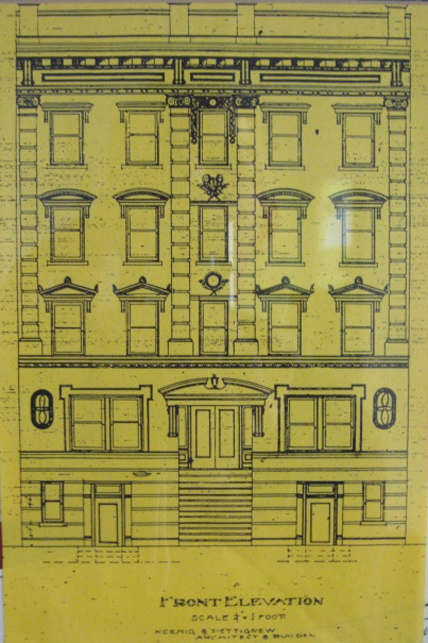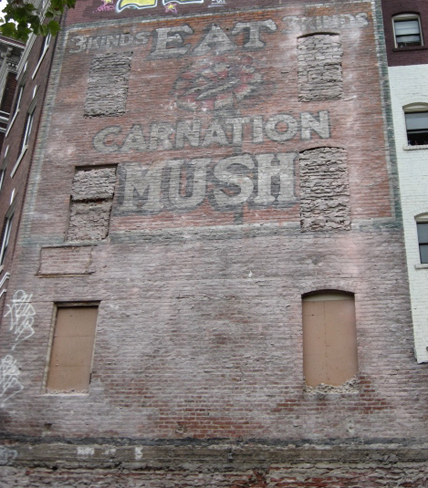By Henry Ostendorf
Last week’s demolition of an abandoned warehouse on Market Street uncovered this “3 Kinds – Eat Carnation Mush” billboard at the gateway to Hayes Valley (Market at Franklin Streets). For those who are wondering, “mush” is now better known as polenta. And it’s probably being served at the Zuni Café half a block down Market tonight.
Apparently in the early 20th century Carnation “held the world milk production record for 32 consecutive years.” One particular cow “produced 37,381 pounds of milk during 1920”. So I’m assuming canned Carnation Mush was a way of selling this excess milk to working folk living in the hotel district at the eastern boundary of Hayes Valley.
Yes, Hayes Valley had a hotel district. I discovered this when visiting the unassuming lobby of the Opera Apartments at 145 Fell Street. Found on display there are clippings of neighborhood hotels and the musical history of the area. The text below is from one of the clippings complied by the building’s management.
The Historic Opera Hotel Apartments.

In 1907, the year following the great earthquake and fire, the City was beginning to rebuild…especially around the Civic Center district. The Opera Hotel Apartments on Fell Street between Van Ness and Franklin was built in 1907 and operated for many years as the Hotel St. Cecile, just up the street from the still existing Oak Hotel and the Whiteside Apartments on the corner of Franklin. The Masonic Temple at 25 Van Ness between Oak and Hickory was built in 1912 and loomed large in the area as the scattered building projects began.
The Hotel St. Cecile, with palatial entry and classic Edwardian styling occupied front floors. The laundry and support services for the hotel operated on the ground floor. The floor plans and elevations by Koenig and Pettigrew Architects are for the original Hotel St. Cecile.

In the early years of the twentieth century this hotel began to acquire a reputation for being a temporary home to visiting opera players and stars as San Francisco gained more cultural as well as commercial prominence.
In more colorful days the two major opera houses in the area were the Tivoli Opera House and the Grand Opera House. The Tivoli closed its doors in 1888 and the Grand was closed by the devastating earthquake and fire in 1906.
The opera would continue in San Francisco for the next ten years in various theaters and halls then took up residency at the newly built Municipal Auditorium (now the Bill Graham Civic Auditorium) in 1914 as part of the Panama-Pacific Exposition. Finally in 1932 the Beaux Arts style War Memorial Opera House was built at Van Ness and Grove.
Somewhere along the way the Hotel St. Cecile’s name was change to the Opera Hotel to reflect this operatic connection.
In the early 1950’s a devastating fire gutted the interior of the hotel leaving only the original façade and brick shell. When it was rebuilt the hotel became a five-story apartment building.
As to which opera stars might have frequented the Opera Hotel, no records or clippings have revealed clues. But the hotel now named the Opera Hotel Apartments, honors the connection and it’s place in the fascinating history and evaluation of San Francisco. –Opera Apartments Management.

